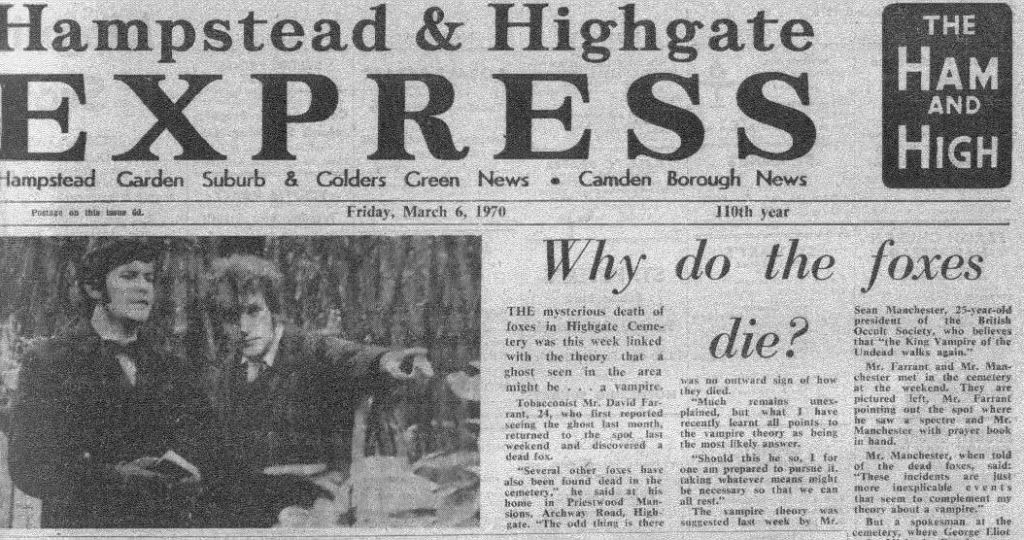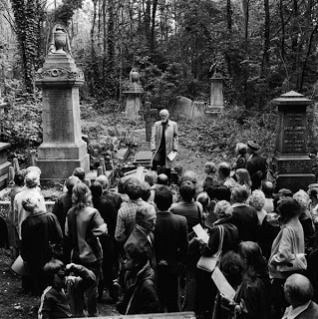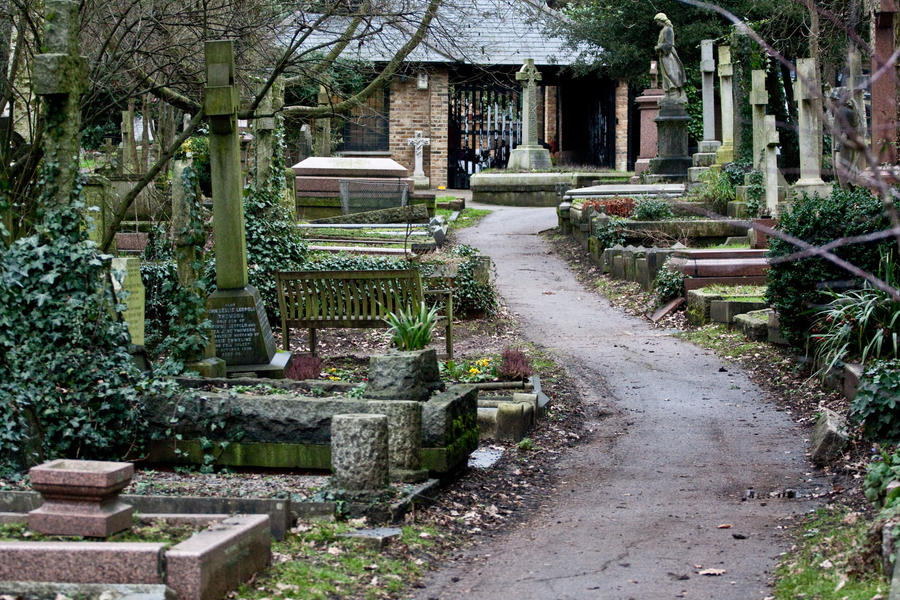In his interview of 27 February, Manchester offered no evidence in support of his theory. The following week, on 6 March, the same paper reported David Farrant as saying he had seen dead foxes in the cemetery, 'and the odd thing was there was no outward sign of how they died.' When told of this, Manchester said it seemed to complement his theory. In later writings, both men reported seeing other dead foxes with throat wounds and drained of blood.
Farrant was more hesitant in identifying the phenomenon he had seen. In some interviews he called it simply a ghost or spectre, sometimes he agreed that it might be vampiric. It is the 'vampire' label which has stuck.
The Mass Vampire Hunt of March 1970
The ensuing publicity was enhanced by a growing rivalry between Farrant and Manchester, each claiming that he could and would expel or destroy the spectre. Manchester declared to his associates that he would hold an 'official' vampire hunt on Friday 13 March—such Fridays are always ominous dates in British and North American superstition (Friday the Thirteenth), and are frequently chosen for items on occult matters in the media. ITV then set up interviews with both Manchester and Farrant, and with others who claimed to have seen supernatural figures in the cemetery. These were broadcast on ITV early on the evening of the 13th; within two hours a mob of 'hunters' from all over London and beyond swarmed over gates and walls into the locked cemetery, despite police efforts to control them.
Manchester's exorcism claims
In later years, Manchester wrote his own account of his doings that night (The Highgate Vampire 1985; 2nd rev. ed. 1991). According to his narrative, he and some companions entered the cemetery, unobserved by the police, via the damaged railings of an adjoining churchyard, and tried to open the door of one particular catacomb to which a psychic sleepwalking girl had previously led him; but try as they might, it would not budge an inch. Failing in this, they climbed down on a rope through an existing hole in its roof, finding empty coffins into which they put garlic, and sprinkling holy water around.
Some months later, on 1 August 1970 (Lammas Day), the charred and headless remains of a woman's body were found not far from the catacomb.[citation needed] The police suspected that it had been used in black magic. Soon after this incident, there was a noticeable surge in both Farrant's and Manchester's activities. Farrant was found by police in the churchyard beside Highgate Cemetery one night in August, carrying a crucifix and a wooden stake. He was arrested, but when the case came to court it was dismissed.
A few days later Manchester returned to Highgate Cemetery, but in the daytime, when visits are allowed. Again, we must depend on his own published book for an account of his actions, since neither press nor police were present. He claims that this time he and his companions did succeed in forcing open, inch by inch, the heavy and rusty iron doors of a family vault (indicated by his female psychic helper). He lifted the massive lid off one coffin, believing it to have been mysteriously transferred there from the previous catacomb. He was about to drive a stake through the body it contained when a companion persuaded him to desist. Reluctantly, he shut the coffin, put garlic and incense in the vault, and came out from it.
A later chapter of Manchester's book claims that three years afterwards he discovered a vampiric corpse (he implies that it was the same one) in the cellar of an empty house in the Highgate/Hornsey area, and staked and burned it.
Manchester's story is full of melodramatic details mirroring the Dracula mythos: the sleepwalking girl; the vampire transported to England in a coffin; a coffined corpse 'gorged and stinking with the life-blood of others', with fangs and burning eyes; his own role as a Van Helsing figure.
If he did indeed act as he describes, it can be regarded as a good example of what folklorists (following terminology established by Linda Degh) now call 'ostension' and legend tripping. This means the real-life imitation of elements from a well-known tale, often involving role-playing, and sometimes leading to ritual acts of vandalism and desecration.
Aftermath
There was more publicity about Farrant and Manchester when rumours spread that they would meet in a 'magicians' duel' on Parliament Hill on Friday 13 April 1973, which never came off. Farrant was jailed in 1974 for damaging memorials and interfering with dead remains in Highgate Cemetery—vandalism and desecration which he insisted had been caused by Satanists, not him.
Both episodes kept memories of the Highgate affair vivid. In 1975 Manchester wrote a chapter about it in a book edited by Peter Underwood, a well-known popular writer on ghost lore. The Highgate Vampire is now regularly featured in books and internet sites on occult subjects.
The feud between Manchester and Farrant remains vigorous to this day; each claims to be a competent exorcist and researcher of the paranormal; each pours scorn on the other's alleged expertise. They continue to investigate supposed supernatural phenomena, and have both written and spoken repeatedly about the Highgate events, in every medium available, each stressing his own role to the exclusion of the other.
In her book, Blood Lust: Conversations with Real Vampires, published by HarperCollins in 1991, author Carol Page describes her lengthy interview with Sean Manchester, further questioning his credibility and describes his self-proclaimed activities as "the real evil in Highgate Cemetery."
Source: http://en.wikipedia.org/wiki/Highgate_Vampire
Versione Italiana:
http://inovemondi.forumfree.it/?t=65535205
Versione Italiana:
http://inovemondi.forumfree.it/?t=65535205







No comments:
Post a Comment